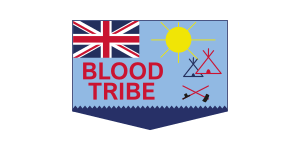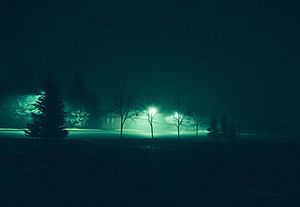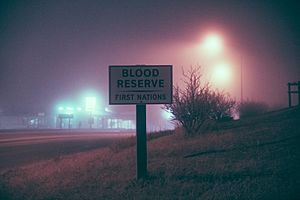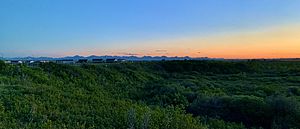Kainai Nation facts for kids
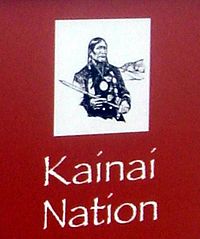
Shield of the Kainai Nation
|
|
| People | Blackfoot |
|---|---|
| Treaty | Treaty 7 |
| Headquarters | Standoff |
| Province | Alberta |
| Land | |
| Main reserve | Blood 148 |
| Other reserve(s) | |
| Land area | 1362.639 km2 |
| Population (2019) | |
| On reserve | 8,751 |
| Off reserve | 3,948 |
| Total population | 12,699 |
| Government | |
| Chief | Roy Fox |
| Council |
|
| Website | |
| bloodtribe.org | |
The Kainai Nation, also known as the Blood Tribe, is a First Nation group in southern Alberta, Canada. In 2015, about 12,800 people were members of the Kainai Nation.
The name Káínaa means "Many Chief people." Another name for them is the "Blood Tribe." This name came from the Plains Cree, who called them Miko-Ew, meaning "stained with blood."
The Kainai speak a language from the Blackfoot family. Their language is similar to the Siksika and Piikani nations. The Kainai are one of three nations that form the Blackfoot Confederacy.
When treaties like Treaty 7 were signed, the Kainai lived near the Oldman, Belly, and St. Mary rivers. These rivers are west of Lethbridge, Alberta. The Kainai reserve called Blood 148 is the largest in Canada. It covers about 1,414 square kilometers (545 square miles). About 4,570 people live there. The reserve is located about 200 kilometers (125 miles) south of Calgary.
Contents
How the Kainai Nation Earns a Living
The Kainai Nation is involved in many different businesses. They trade with partners both in Canada and other countries. For example, they mine a rare gem called Ammolite. This gem is very popular in Asia for Feng Shui.
Ammolite is only found in the Bearpaw Formation. This is because special conditions long ago helped marine life turn into Ammolite fossils. Over the years, mining has uncovered many ocean dinosaur fossils. These fossils are kept at the Royal Tyrrell Museum for study. However, they belong to the Kainai Nation.
Important Land Agreements
The Kainai Nation has made many specific claims with the federal government. In 2017, a court decided that the government had miscalculated the nation's population. This meant the Kainai reserve was smaller than it should have been.
Because of this, the Blood Tribe reserve could grow by 421 square kilometers. The community could also choose to receive money instead of more land.
In 2019, the Kainai Nation settled a claim about how the government managed their ranching businesses. The community received $150 million. Chief Roy Fox said that $123 million of this money would be used for new homes and buildings. It will also help build a new skating rink.
How the Kainai Nation is Governed
The Band Council
The Kainai Nation is led by an elected council. This council has twelve to fifteen members and one chief. They serve for four years.
Here are some of the past chiefs of the Kainai Nation:
- Last of the Hereditary Chiefs Traditional Chief Jim Shot Both Sides (1956–1980)
- Chief Chris Shade (1996–2004)
- Chief Charles Weasel Head (2004–2016)
- Chief Roy Fox (Makiinimaa – Curlew) (2016–Present)
|
Blood 148
|
|||
|---|---|---|---|
| Blood Indian Reserve No. 148 | |||
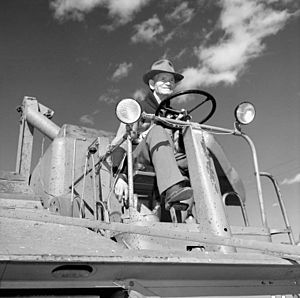
James Gladstone on his combine harvester
|
|||
|
|||
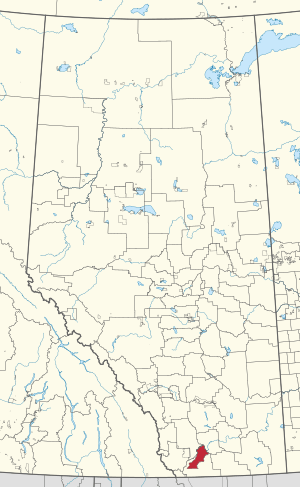
Location in Alberta
|
|||
| First Nation | Kainai Nation | ||
| Country | Canada | ||
| Province | Alberta | ||
| Municipal district | Cardston | ||
| Headquarters | Stand Off | ||
| Government | |||
| • Body | Blood Tribe Council | ||
| Area | |||
| • Total | 1,413.87 km2 (545.90 sq mi) | ||
| Population
(2021)
|
|||
| • Total | 4,572 | ||
| Time zone | UTC−7 (MST) | ||
| • Summer (DST) | UTC−6 (MDT) | ||
| Highways | Highway 2 | ||
Blood 148 is a special area of land in Alberta, Canada. It is known as a First Nations reserve. This land is home to the Blood people, also called the Kainai. The reserve was created as part of an important agreement called Treaty 7.
The Blood 148 reserve is managed from a community called Stand Off. This community is located on the reserve's northwest side. The reserve covers most of the land between the cities of Fort MacLeod, Lethbridge, and Cardston. Important highways like Highway 2, Highway 5, and Highway 509 run through it. Two main rivers, the St. Mary River and the Belly River, flow through the land.
Blood 148 is very large. It covers about 1,413.87 square kilometers (545.90 square miles). This makes it the biggest reserve in all of Canada. It is also the third most populated reserve. Only Six Nations and Akwesasne have more people. In 2019, a court decided that the Blood Tribe should have even more land. This was based on the original promises made in Treaty 7. The reserve is next to the cities of Fort MacLeod and Lethbridge. It also borders the town of Cardston.
Who Lives in Blood 148?
In 2006, about 4,177 people lived on Blood 148. They lived in about 1,250 homes. This was an 8.4% increase from 2001. By 2018, the Alberta Government reported that the population had grown to 4,713 people.
The reserve is very large, so the people are spread out. In 2006, there were about 3.0 people per square kilometer. This is called the population density. As of December 2013, government records showed that the Blood band had a total of 11,791 registered members. These members live on reserves 148 and 148A.
The Police Force
Long ago, before treaties, a group called the iikunuhkahtsi was in charge of punishing wrongdoings. Today, the Blood reserve is policed by the Blood Tribe Police. In 2015, there were 31 officers.
Notable People from the Kainai Nation
- Cherish Violet Blood - a stage and film actress
- Red Crow - a chief who signed Treaty Number Seven in 1887
- Byron Chief-Moon - a performer and choreographer
- Eugene Creighton (Owns Many Horses)
- Eugene Brave Rock - an actor and stunt man
- Faye HeavyShield - an artist
- Marie Smallface Marule - an academic, activist, and educator
- Natawista Iksina (1825-1893) - an interpreter and diplomat
- Jerry Potts
- Pete Standing Alone
- Seen from afar (1810-1869) - a chief of the Blood tribe from 1810 to 1869
- Elle-Máijá Tailfeathers - a Kainai and Sámi actress, producer, and filmmaker
- Tom Three Persons - a rodeo athlete and rancher
The Kainai Nation in Popular Culture
In 1960, the Kainai Nation and their important Sun Dance were shown in a documentary. It was called Circle of the Sun by the National Film Board of Canada. Tribal leaders allowed the filming because they wanted a record of the Sun Dance.
In 2006, a community leader named Rick Tailfeathers made a small ammolite carving. It was a buffalo skull. This carving was placed inside Voyageur, a special guitar in the Six String Nation project.
On National Indigenous Peoples Day in 2011, a film trilogy about Pete Standing Alone was released. It included Circle of the Sun, Standing Alone, and Round Up. These films show 50 years of the Kainai Nation's history.
Historical Newspapers
- The Kainai News was one of Canada's first Indigenous newspapers. It was very important for Indigenous journalism in Canada. The Blood Indian Tribe published it in southern Alberta. It covered local issues on the reserve and national topics. These included the Indian Act and the Whitepaper. The newspaper often featured cartoons by Everett Soop. Its first editor was Caen Bly.
- The Sun Dance Echo was an earlier newspaper. It was edited by Reggie Black Plume. Sometimes, it included articles by Hugh Dempsey.
Communities of the Kainai Nation
The Kainai Nation has several communities, including:
- Bullhorn
- Fish Creek
- Ft Whoop Up
- Levern
- Moses Lake
- Old Agency
- Standoff
Images for kids
-
Stu-mick-o-súcks, Buffalo Bull's Back Fat, Head Chief, Blood Tribe, 1832 by George Catlin
-
Stsimaki (Reluctant-to-be-woman) - Blood by Edward S. Curtis


